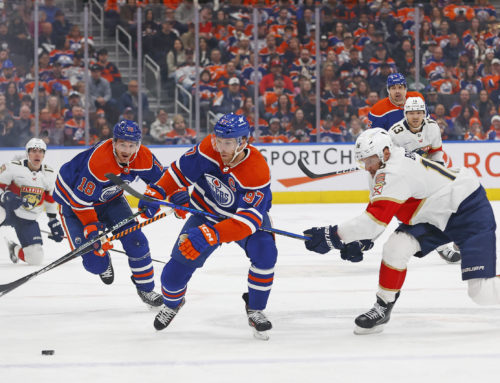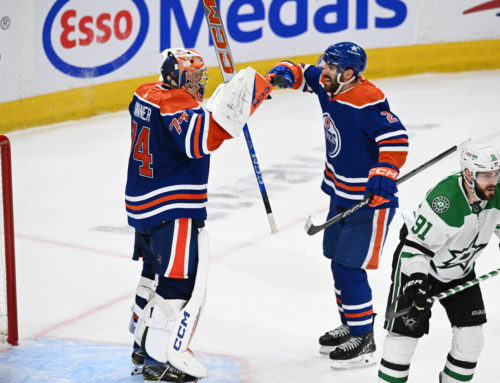More and more fans and hockey pundits are referring to advanced stats in their evaluations. Some have become quite good at it, others struggle a little to grasp the concepts, and many often take the results out of context. (Read Part 2 – the charts – here)
My background: I have a university Degree in Statistics along with a Minor in Mathematics, so I can help somewhat in getting your head around navigating through a few of these metrics. Everyone has their favorites, and below I am going to give you mine. These are the stats I look at when evaluating players during the season, or reviewing them in the summer. The most important thing to remember when looking at any evaluative or predictive stat is that it's not perfect. Not close. Otherwise, every general manager (and fantasy owner) would have the perfect team.
RULE 1: The sample size is still small. The main reason for any hockey stat's imperfection is sample size. An 82-game season, in the statistics world, is virtually nothing. Statisticians prefer sample sizes well into the thousands. If the league was 10,000 players deep and they played 10,000 games per season, then you would have yourself some very strong and accurate predictive/evaluative results. But we don't. We have 82 games per player (if that) and approximately 900 players each year (2021-21 actually saw 1004 players). All you can do is use the results as indicators – and only that. The deeper into the season, the more games that contribute to the stat, the more accurate the stat becomes. But it will never be perfect even after a player plays 1000 games, because a player will not play those games with equal skill and experience. A player will improve, peak, and then decline.
RULE 2: Do not take the statistic out of context. To understand what one stat is telling us, you need to look at the other stats. A player with an amazing CF% (see below) may tell us that he's been pretty good at creating more chances than what is given up when he's on the ice, which is promising. But without knowing his zone starts and quality of competition (or quality of teammates), you just don't know. A player with a great IPP (see below) of 80% is also promising. But that stat isn't as impressive if he accrued it while playing on the fourth line, as opposed to the first line.
If you follow the above two rules, you'll avoid common mistakes. And as a bonus – you will no longer plant your flag on a player's skill level showing potential or on a player's skill level being horrible. The Twitter arguments between the 'eyeball test' people and the 'analytics' people would stop as both sides allow for a bit of leeway in their stance. Well, okay maybe not. But a man can dream!
Here are the stats I look at, in alphabetical order. All of these stats can be found in our Frozen Tools section:
%PP: The percentage of a team's available power-play time that a player is on the ice. If it is over 60%, you can safely assume that player is on the first power-play unit. Useful for comparing a player to a teammate who plays the same position – who is favored more to get the PP ice time? Sometimes I will check a player's profile page on Frozen Tools, as the player's PP time is broken down by quarter. It can be useful to see if the per-game PTOI has been steady all season long or if it has steadily risen with each quarter.
5on5 S%: This is the shooting percentage of a player and his teammates when that player is on the ice. Generally speaking, a player who is on the ice when his teammates (and himself) are shooting 5.5% is going to get more points next season just from the puck going in at the proper rate (i.e. 'market correction'). League-wide, the average shot percentage is about 9.5-9.8%. It has been higher lately, in my opinion due to the goaltender pad regulations (give a shooter an extra inch to shoot – there will be more goals). Leaguewide average shot percentage:
2021-22: 9.8%
2020-21: 9.7%
2019-20: 9.5%
2018-19: 9.5%
2017-18: 9.2%
2016-17: 9.0%
2015-16: 9.0%
2014-15: 8.9%
These days the average player, over enough games, will see his 5on5 S% approach somewhere around 9.65% or slightly higher.
CF%Rel (Corsi-For% Relative to competition): Corsi is really just a plus-minus stat – but instead of being strictly for goals, it is for all shot attempts (shots on goal, shots that miss, shots that are blocked). Corsi-For% is the difference between that player's CF and CA (shot attempts against). CF%Rel is the above number, but it adjusts for the competition on the ice (i.e. Quality of Competition).
IPP (Individual Points Percentage): This is the percentage of the goals scored by a player's team while he was on the ice, on which he picked up a point. This is mainly useful when looking at it year over year. A decline in this number is an indicator of an erosion in talent, often due to age or injury. It is also helpful in determining if that player is too good for the line he is on. If his IPP is fairly high and he's on the third line, then he is definitely a candidate for seeing a few shifts on the second line.
Pts/60 (Points per 60 minutes of ice time): This is pretty self-explanatory. Since ice time is not equal across all players, what happens when we make it equal? A great way to see how up-and-coming players are doing with the ice time that they are given.
QofC (Quality of Competition – aka CorsiRel QofC): This is a way of measuring how strong the competition is that a player sees throughout the season. A player seeing the top line every game would obviously see a QofC number on the high end of the scale (say +1.20). A player seeing the fourth line every game would see something closer to -1.20. It’s measured by taking the average of the CorsiRel of each player on the opposition that's on the ice. Seeing a high number here tells you that he’s in good with the coach and can expect more responsibility next year (if it’s a young player), or that he's a superstar (if it’s a veteran).
TOI (Time on the Ice): I like to look at a player’s ice time and power-play time (PPTOI) to see if he is being used the way he should. It's really only an issue with young players, or one-dimensional players. I also like to see if the ice time in general was moving in an upward direction as the season went on. Seeing a rookie getting time on the penalty kill (PKTOI) is also a good reflection of the coach’s trust. Our player profiles also have ice broken down quarterly on the main page – a great way to see at a glance if he's getting more trust or less trust from the coach.
xGF/60 (Expected Goals-For per 60 minutes of ice time): Imagine every shot attempt, by location, being recorded, evaluated, ranked for quality, and adjusted further according to who was taking it. Well, that's actually done. The xGF is a ranking of that shot attempt. A shot from a bad angle by a weak player may only give his teammates on the ice a 0.05. A shot from a great angle by a strong player may give he and his teammates on the ice a 0.50. Now add all those instances up for each player and divide it into 60 minutes. A very simplified explanation, but you get the gist. If a player has an xGF/60 of 2.71 and an xGA/60 of 2.57 then he is creating more chances to score than he is giving up.
xG% (Expected Goals Percentage): This was pretty much described above, taking the xGF and xGA and getting a percentage. Positive is better.
ZS% (Offensive Zone Start Percentage): What percentage of a player’s shifts begin in the offensive zone? If the number is 65%…then he’s either being pampered by the coach, or he’s being leaned on by the coach to score goals. Often both. If that number is 35%, then he’s obviously a checker, and even if he’s putting some points on the board, it’s probably safe to assume that his production is not going to improve in the season ahead.
These are the stats that I look at when evaluating a player's odds of being used in more optimal situations, or even just trying to determine how much of his surprising production can be attributed to some good (or bad) bounces. If we're looking at a younger player and the analytics above show promise, then chances are he will see better ice time ahead and likely take that next step. If we're looking at an older player and his production and analytics are starting to nosedive, then chances are he is indeed heading into the twilight of his career. Or if a player has great production but very weak analytics, then I identify that player as a risk, with numbers that 'could' just be a house of cards.
As for PDO (aka 'SPSV%'), I find that I know longer use this one, focusing instead on the 5on5 S% component. PDO is an okay statistic to quickly draw your attention to any player with an abundance of luck (good or bad). It takes the 5on5 S% + 5on5 SV% and the distance it deviates from 1000 tells you if he was the victim (or beneficiary) of some lucky bounces. But since fantasy hockey is mostly about offense, focusing on 5on5 S% is more prudent.
Coming up next – a look at how to read the analytics charts in Frozen Tools





 PHI
PHI TOR
TOR ANA
ANA NYI
NYI BUF
BUF CGY
CGY VAN
VAN CAR
CAR STL
STL MTL
MTL CBJ
CBJ
